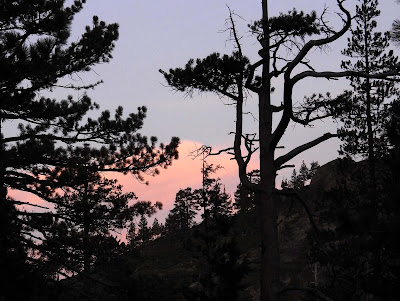Full Moon 9/15/19
We had a great time camping and kayaking last weekend! The weather was great, and fall colors were starting to show up everywhere! We hiked for 3 days in the Lakes Basin, and kayaked one evening on Sardine Lake! Unfortunately, the moon wasn't up when we kayaked, but it was lovely and peaceful on the water! When I woke up on Sunday morning at 6:00, the moon was still up and the sunrise colors were gorgeous!
Sunrise colors on the Clouds
Grassy Lake 9/14/19
The vegetation in and around Grassy Lake is just starting to turn fall colors. There were still a few waterfowl on the lake. They should start migrating down to lower elevations as the daylight hours shorten and temperatures get cooler.
Mallard - Common Mergansers - Bufflehead
Anas platyrhynchos - Mergus merganser - Bucephala albeola
Western Eupatorium - Pearly Everlasting - Long-leaved Aster
Ageratina occidentalis - Anaphalis magaritacea - Aster ascendens
We saw lots of late-blooming flowers in the Lakes Basin, mainly Goldenrod, Asters, and Pearly Everlasting. Near Saxonia Lake we came across one blooming Western Eupatorium, in a shady, cool stream channel we have affectionately named "Garden Gulch"! Their super-long stamens are amazing!
Lost Lake 9/13/19
We hiked to Lost Lake on Friday, which is less than a mile off of the Deer Lake Trail. It was almost all dried up, but to my delight we found hundreds of salamander larvae in it! Wow!!! I had never seen them in such numbers before!
Pacific Chorus Frog (treefrog) - Southern Long-toed Salamander (larva)
Pseudacris regilla - Ambystoma macrodactylum sigillatum
Not all salamanders have aquatic larvae. Some hatch out as adults from eggs that are laid in damp, moist areas such as underneath decaying vegetation on the forest floor, or in decomposing logs. Some aquatic salamanders hatch from eggs laid in slow flowing streams. What we saw were Southern Long-toed Salamander larvae, that typically hatch from eggs laid in ponds. They usually spend 1-2 years as aquatic larvae, before they emerge from the ponds as adults. While underwater they breathe with gills that are located on both sides of their body, right above their front legs. You can just see them in the photo above right. As larvae they feed on aquatic insects, copepods, ostracods, snails, leeches, annelid worms, and tadpoles! As adults these salamanders have bright yellow splotches on their backs. I've never seen an adult! I'll have to look for them next Spring when we re-visit Lost Lake!
We saw several aquatic insects, tadpoles, and a leech in the pond. There were also some tiny Pacific Chorus Frogs (treefrogs) (above left photo) in the shallow water. They are easily identified by the black stripes on the sides of their head.

White-headed Woodpecker - Downy Woodpecker - Clark's Nutcracker
Picoides albolarvatus - Picoides pubescens - Nucifraga columbiana
We saw quite a lot of birds foraging for food in the Lakes Basin. Some of them, such as the Woodpeckers and Brown Creepers, are year-round residents. Others, such as the Bluebirds and Sparrows, will start migrating to lower elevations soon.
Brown Creeper - Mountain Bluebird (female) - Song Sparrow
Certhia americana - Sialia currucoides - Melospiza melodia
Grizzly Peak 9/16/19
It Rained!!!
On Monday and Wednesday this past week it POURED rain for hours! We had lots of thunder and lightning, but luckily no fires. Our total rainfall for those two days was 1.66"!!! We are so grateful that the danger of fires has been diminished by this downpour! Yahoo! It was so fresh, moist, and fragrant! While we were camping, I learned that there's an actual word for the lovely fragrance of the dampened earth after a rainstorm, it's "petrichor"! I also learned that there's a name for people who love rain, it's "pluviophiles"! The following definition is from the website http://www.word-detective.com.
"According to the Oxford English Dictionary, “petrichor” is “A pleasant, distinctive smell frequently accompanying the first rain after a long period of warm, dry weather in certain regions.” If you’ve ever been captivated by the smell of a sudden summer shower, “petrichor” is your word.
Although “petrichor” sounds quite poetic and ancient, it’s actually of fairly recent vintage, having been coined in the pages of the scientific journal Nature in 1964. Evidently, organic compounds in the air, most emitted by plants, fall to earth and combine over time to produce an oily resin, essentially a complex perfume, in the dry ground. The globules of this perfume are then liberated and spread by falling rain, producing that distinctive smell. “Petrichor” is thus much more than just the smell of wet dirt.
In naming this compound and its wonderful scent, the scientists in Nature reached back to Latin and Greek. “Petro” (from the Latin “petra”) is a combining form meaning “stone” (also found in “petroleum” and “petrified”), while “ichor,” from Greek, means “essential fluid” or, in a poetic sense, “essence.” So “petrichor” means “essence of stone,” which may not be scientifically precise but strikes me as the perfect name for that smell."
Alders in the Rain!
California Tent Moth caterpillars - Malacosoma californicum
My Mistake!
Two weeks ago I said that the California Tent Moth caterpillars only feed on "deciduous" trees. I should have said "leafy" trees! They feed extensively on Madrone Trees, which are leafy but not deciduous! I apologize for my error!
What kind of bug is this? What is it doing?
Where are the bears?
Is Fall around the corner?
Check back next week for the answers to these questions and more!
If all of a sudden you haven't been getting email notices of my blog being published, just sign up again on my blog. I don't know why you got "unsubscribed". It's some kind of problem with Blogspot.com and/or FeedBurner.com. I apologize for this glitch!
Your questions and comments are greatly appreciated!
Please email me at northyubanaturalist@gmail.com












No comments:
Post a Comment